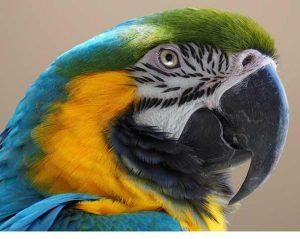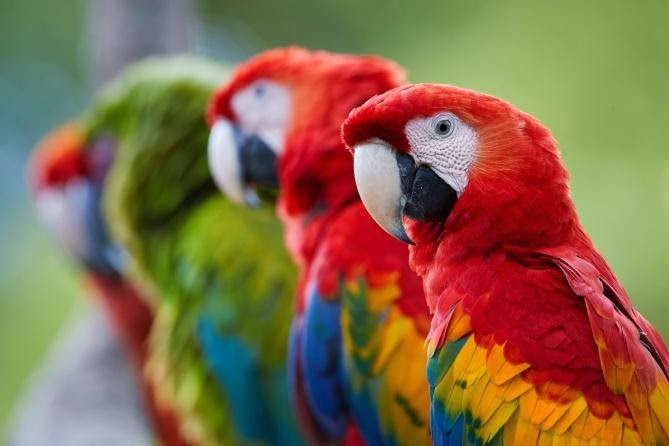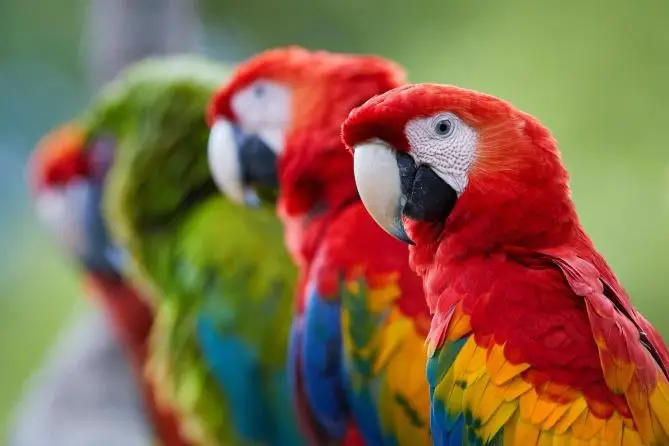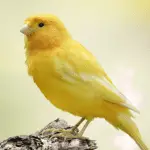One of the unique traits and behaviors that pet birds like macaws and parrots are blushing. Similar to the face of a human, a bird’s face has large networks of blood vessels along the cheek and neck. These blood vessels fill with blood almost automatically when there are certain stimuli.
Unknown to most people, birds are affected by a wide range of emotions like fear, happiness, and anger. But it can’t easily tell you that it’s mad or glad. Also, we mistake most of the birds’ behavior, and this only frustrates your pet bird further.

We came up with a guide to help explain why birds like parrots and macaws blush and how you should react to this behavior based on these eight possible reasons.
1) To communicate their emotions
We blush when we’re happy, anxious, or nervous, and your pet may do so as well. It starts with identifying stimuli, something that can trigger that strong and uplifting emotion, and this can instantly start the heart to pound faster and deeper, and this delivers blood to all parts of the body, including the face. Pet birds with pale faces can easily show blushing as a result of certain stimuli, but it may already be feeling a burst of emotions
Also, a blush may only be seen in the face, but since blood flow is increased in all parts of the body, it is possible that your pet is experiencing flushing or an overall increase in body temperature.
So how do you deal with blushing as a result of your pet’s emotions? You don’t have to do anything about it. Just let your pet be. Blushing will only be temporary and will not cause any health problems for your pet. Just identify the stimuli that may have caused this behavior in your pet.
Look for signs of blushing like a new person in the house comes near the cage, a new pet is nearby, or a new parrot or bird is visible from your pet’s cage. It may be scared too, like a loud sound from your TV or radio or a weird sound coming from the outside. Remember, you can’t shield your pet forever, so you need to let him adjust to these situations and just carry on as if nothing happened.
2) To communicate what they need
As mentioned, your pet bird has no way of telling you that it is angry, happy, or sad and to tell you that they need to be fed or they need water or attention. And this can make them feel frustrated and thus can trigger blushing and other behaviors like flapping their wings, fluffing their feathers, and more.
So how do you deal with this problem? Consider checking all possible things that your pet bird may need. Check if its food bowl is empty or full, replace water inside its dish, check if the cage is in good condition or the temperature is too hot or too cold. If everything checks and your pet is still blushing, look for stimuli.
Check for any loud sounds indoors and outdoors, check if anyone new has come in that triggered the behavior or any animal like a pet may have started your pet’s behavior. If blushing persists with other unwanted pet behavior, then it could be something that your pet is feeling, or it may be unwell. Take it to the vet if this behavior persists.
3) Macaws blush during social interactions
A study revealed that macaws and other birds have the tendency to blush during social interactions. Along with blushing is feather-ruffling, flapping, and making unique sounds. This is often seen when you as his favorite person or other people are playing with it or trying to interact with it.
Blushing can last for only a few minutes as the bird will finally get used to the attention. Think of you giving a speech in front of a large audience. You’ll feel very anxious and probably blushing as you try to deliver your speech! But gradually, you’ll get used to being in front of a large crowd and will soon warm up and feel relaxed. This is the same thing that pet birds feel when people surround their cages and try to interact with them.
Sometimes, pet owners may see this behavior in one on one interactions with their pets as well. Experts say that this is natural since your pet may be anticipating a good time. Your pet may know you as a loving and caring owner who wants to interact with him. You are known for giving the best treats and for the best games, and your pet may be looking forward to these as well.
And just like any other reason for blushing, the red flush will eventually recede, and your pet will become calmer and more at ease to your handling. But expect the same thing tomorrow when training and interaction time comes round.
4) Blushing due to sexual selection
Another reason why birds blush is during sexual selection. Macaws are known to breed for life, but while selecting the right individual to mate forever, it can take a very long time for a bird. Usually, the selection process involves a lot of feather-ruffling, showing off its colorful outer and inner feathers and possibly dancing and singing. Also involved is blushing, which happens because the birds are in such heightened emotions.
Blushing is very prominent in males as they will try to court their potential mates. But females may not be as receptive. But once the pair have found each other, blushing subsides as the two become more at ease with each other.
Breeding can take time for some birds, but in macaws, it can vary depending on the environment. A pair may have found each other, but if the environmental conditions are not right, they may not breed and postpone it till the next breeding season. It is possible that macaws may find another mate after some time because, despite breeding for life, the bond of the two may not be as strong.
5) Blushing due to aggression
Captive macaws can become very territorial, especially when two or more males are placed in a small cage. At some point, one of the macaws will surely try to gain authority and establish his territory, and this can lead to fights and even as far as hurting each other.
Pet owners who have observed these territorial fights have seen that their pet male macaws are blushing. Their pale faces flushed with red, and aside from this are screeching, flapping their wings like crazy and even using their beaks and claws to threaten their cage mates.
This is very dangerous behavior in birds and should be dealt with fast. If you neglect territorial battles like this, one of your pets can get heavily injured. You can remedy this by placing your pets inside separate cages. It’s no use placing them in a larger cage because it is likely that this behavior can happen again.
Pet macaws may also feel some negative behavior towards people, especially new people who would like to pet or do anything with them. You may have experienced this, too, while you were just new to handling your pet. Your pet bird may have been suspicious of you and may not trust you to hold it. But eventually, it has learned to trust you and find you as a favorite person.
6) Blushing when with a favorite person
If your bird is blushing while with you or his favorite person, there’s nothing wrong with this at all. As mentioned, your pet may just have a feeling of anticipation, joy, and happiness that you are here with him.
Pet owners have seen blushing in pets that have not seen them for a very long time. Take note that parrots have good memories, and although they don’t have the feeling of missing someone that’s gone home, they may feel excited and startled at the same time. They may blush uncontrollably and start to screech and flap their wings as a sign of happiness.
But some owners say that it’s different when the favorite person goes away for a long time. Pet parrots and macaws can even grieve when their owners have died or have abandoned them. If a pet parrot in your home has recently lost his loved one or his favorite person, then you might find it in a depressed mode. It may not eat, sleep, or may sometimes look anxious.
7) Blushing together with other cues
As we mentioned a while ago, blushing can also happen together with other cues, including feather ruffling and puffing of their neck feathers. Usually, when this happens, your pet bird may be experiencing extreme stress.
Just like humans may show different signs of stress, birds may also have these behaviors like not eating, not drinking, just staying on one place in the cage, screeching, walking in circles, and in severe cases, may pick on its feathers. Some severely stressed birds may remove their feathers one by one for no reason at all. It’s hard to stop these birds from doing this on themselves, and usually, it’s best to find the reason why this has happened.
Birds can become easily stressed, especially when there’s something new in their daily routines. Unplanned activities like traveling, evacuations due to storms, fires, etc. or simply placing it in a new cage for clean up can lead to stress. As a pet owner and your pet’s favorite person, you should know how to deal with your pet’s stress or anxiety issues. We’ll discuss this later because you just can’t leave a parrot stressed or anxious for a long time.
8) Blushing due to medical or health issues
Humans blush when we have a high fever, an infection, or an inflammation. We also blush because our body is trying to control diseases. Blushing and flushing are two very important signs of illness in humans, and this can also be true for birds like macaws.
When you spot blushing for no other reason at all, and this persists, it may be likely that your pet is suffering from some kind of illness or health condition. Look for other symptoms that can support your theory like poor appetite, weakness, diarrhea, constipation, vomiting, dropping or losing its feathers or drooling/respiratory problems.
Once you spot any of these, take your pet to the vet at once. If you need to drive or commute to the vet, wrap your pet in towels to make it comfortable, and to help with any other symptoms that can cause stress. If your pet has a pet bird carrier, then you can use this to take your pet to the vet.
Your vet will make an initial physical exam, check for symptoms, take blood samples, and stool samples to diagnose your pet’s condition. Aside from these, the vet may also interview you regarding the condition of your pet. Your pet may be started with fluids intravenously and kept in the vet for 24 hours for a complete diagnosis.
Viral and bacterial infections of birds may be contagious to humans, and thus, you may need to clean your pet’s cage with disinfectants and wear safety equipment like masks and gloves. While your pet receives treatment for these infections, it has to be quarantined from other pet birds and from other animals and humans for that matter. You have to be very careful since most bird illnesses that affect humans can be fatal.
Resolve to blush and deal with pet macaw stress

Stress accompanies humans and pet animals. Stress is that nagging feeling, that feeling of uncertainty and anxiety that’s boiling in the pit of your stomach. Different people have different stress triggers as much as different pets like birds have different triggers too. But there’s good news; you can manage stress so you and your pet can live a happier, healthier life. Here are some ways to do it.
1) Interact with your pets more
Experts say that pets that are left alone are more stressed than those who get regular interactions with their owners or other pets. This is also true with pet birds like macaws. If you overlook this cue, your pet will likely become stressed, showing flushing, blushing, and a lot of feather rustling. Sometimes it hard to snap a bird back when it’s used to being solitary or living on its own, and it may not even accept a companion.
Interaction is not merely about giving it food and water and cleaning its cage. You have to learn to handle your bird, take it out of its cage, and just play with your pet. Let it learn all kinds of tricks and become a well-rounded member of your family.
2) Let other people interact with your pet bird too
You’re your pet’s favorite person, but don’t let that end there, include other members of the family in the care of your pet. Let your pet depend on all the people in your home by letting them feed it, clean its cage and, of course, learn new tricks. Your pet may not be receptive for the first time, but remember that it was once the same thing with you!
Just let your kids hang around when you train; it can make a lot of difference. And soon, when your pet is more comfortable and trusting with your kids or other family members, you can let them hold it.
Aside from your immediate family members, let your bird know that there are also other animals in your life. If you have other pets like cats, dogs, other birds, and other animals, make sure that they meet your pet properly. Hold your pet comfortably and let him meet your pets in common ground like your living room or dining area. Don’t let a pet dog peer into the birdcage because this can be very frightening to your pet. Also, taking the cage and placing it near a dog or cat is not a good thing too. As long as your other pets are well-trained and gentle, you can make them meet with the help of your other family members.
3) Let your bird feel confident in front of strangers
Performing tricks is something that can bring joy to you and your pet. But be prepared to show your pet’s talent to other people. Start with your family members and then another performance in front of complete strangers or people your pet may have not met before. To make your pet more confident, praise it, stroke it, scratch its neck or head and give it a lot of treats after its performance. Encourage the audience to clap and to show their appreciation as well. But let the audience remain seated and don’t let them hold or stroke your pet because this can make your pet stressed.
4) Find out what stresses your pet and do something about it
Anything imaginable and unimaginable can stress your pet, and as a concerned pet macaw owner, you need to find out what’s causing this stress and do something about it before things get out of hand.
As mentioned, check everything that can make it feel stressed. From the room temperature to the neighbor’s dog barking, it can be difficult to tell, which makes your pet agitated.
5) Take your pet outdoors, meet other people and other pets
Another way to stop stress and to make your pet less spoiled is to take it out to meet other people and even other pets. With your trusty pet carrier or cage, take your pet to the park or to the playground. Let it see the world and let it feel the sun, rain, and the cold.
If you have friends with similar pets, arrange for a play date. Let your pet observe first, and you observe your pet as well for any signs of stress. You don’t really have to let the birds loose or let them share a cage, but just let the birds meet for the first time.
After a successful play date, you can arrange for other play dates, which can help your pet boost his confidence and lose stress. Maybe after a few more dates, you can place one pet to the other’s cage so they can meet in person. Anything is possible, but don’t rush it and just let the two meet naturally.
6) Give your pet a companion
You can significantly reduce stress by adding another companion but preferably a bird of the opposite gender and only one bird. The best way to introduce two birds is to place each one in a separate enclosure and just slowly place their cages near each other.
Like arranging for a play date, take things slow. You will only agitate and stress both birds if you rush things! So slowly introduce the birds, feed them separately, and give them equal amounts of attention. Do not forget to let the new one be used to your handling and to train it to be trustworthy of you. But do this training away from your first pet. Once the two have completely adjusted (you can tell that they are ready when there are negative blushing, flushing, and feather ruffling), you may now introduce the new bird to the larger enclosure.
7) Use TV, radio and your computer
Another way to reduce stress is by using media. Play music and sounds that your pet will love. Pet macaws appreciate music and can mimic sounds too. Some pet owners say that their pet macaws can mimic sounds and can play them over and over again.
You can also play videos of other birds from your TV or computer. This will also acquaint your pet with the presence of other birds and other pets. You can watch one of these clips or videos with your pet, too, and pet him and talk to him as you watch to reduce its stress.
Conclusion
Macaws blush because of many reasons. They blush when they feel excited, happy, and when sexually aroused. Macaws can also blush because of stress, and as a pet owner, you must do all you can to help your pet conquer stress.
You can interact with your pet more often, train it or teach it some new tricks or use media like radio, television, or the web to keep it entertained. Most of all, give your pet love, attention, and proper care, which is important to relieve stress. This will help your pet have a healthier, happier disposition.



